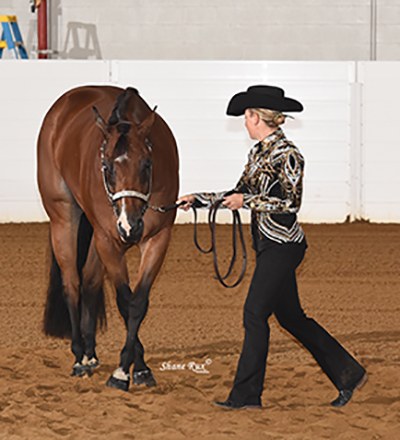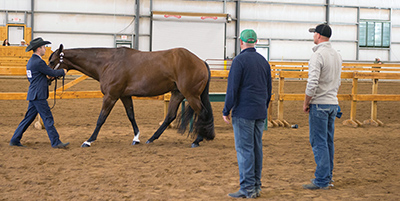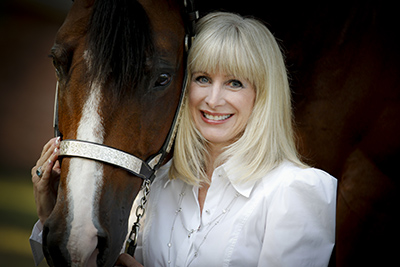 The beauty that results when a Showmanship team performs with perfect unison is something every competitor strives to achieve. In 2017 Ashley Hadock, of Henderson, Tennessee laid down such a pattern with her beloved show partner, Touched N Moonlite, helping her to win the Amateur Showmanship at the All-American Quarter Horse Congress. She compares the class to the sport of figure skating.
The beauty that results when a Showmanship team performs with perfect unison is something every competitor strives to achieve. In 2017 Ashley Hadock, of Henderson, Tennessee laid down such a pattern with her beloved show partner, Touched N Moonlite, helping her to win the Amateur Showmanship at the All-American Quarter Horse Congress. She compares the class to the sport of figure skating.
“You want to look like you are in sync with your horse, it should be like watching figure skating at the Olympics,” she explained. “A lot of practice goes into getting your steps in sync with your horse and keeping everything as crisp and smooth as possible.”
For Jennifer Thompson, of San Angelo, Texas, who holds judging cards from the American Quarter Horse Association (AQHA), American Paint Horse Association (APHA) and the National Snaffle Bit Association (NSBA) the key to a stellar showmanship pattern is correctness.
“I like it when somebody goes out there and owns their pattern,” Thompson said. “They know what they are doing. You can tell that they are well prepared, and they execute it correctly and promptly.”
Tony Anderman, of Saint Cloud, Minnesota, won the 2017 AQHA World Show Level 3 Amateur Showmanship with his 2004 bay gelding, Solo Invested. He stresses the importance of staying on task during the pattern, to make sure it looks effortless.
“I try to stay in the moment during my pattern,” he explained. “Time seems to move faster in the show pen and it’s important to focus on each element and not get ahead of yourself. If I’m struggling with something, it can’t show up on my face or body.”

Ashley Hadlock
Hadlock, who trains under the guidance of Ryan Cottingham added that to be a successful showman you need to learn to show through mistakes.
“For example, I may notice that I didn’t like the way I closed a turn,” she said. “But from the judges’ angle they may not be able to tell that my foot was a half inch off in the set-up or that it wasn’t to my liking. I have to remember to show through my mistakes and not let the judges see that I was unhappy with something, even though it may have been my plan B instead of my plan A.”
All-Around trainer Clint Ainsworth of Lithonia, Georgia, said “good leading” separates the winning Showmanship exhibitor from the rest of the field.
“The most important Showmanship fundamental in my program is good leading,” he said. “It is crucial to have a horse that is light and leads with a handler who works in rhythm with their horse. I put a big emphasis on practicing transitions between the walk to the trot and the trot to the walk, making sure that the horse is listening and that the handler is cuing and maneuvering his horse correctly.”
Jenny Jordan Frid, of Robin Frid Show Horses, in Argyle, Texas, said the most important piece of advice she gives her students as they enter the show arena, is to focus on their job.
“A successful showman should always focus on the task at hand and not what the end goal is,” Frid explained. “When you are focusing on your horse and doing your job correctly, success normally follows.”
Maintaining focus is exactly what Anne Wilson, of Dallas, Texas attempts to do when executing a Showmanship pattern. Teamed with Visable Investment, Wilson won the Showmanship at the AQHA Amateur Select World Show five straight years from 2011 to 2014. Wilson, who trains under the direction of Robin Frid Show Horses, said staying focused throughout all the maneuvers in a pattern is an essential element to success in the arena.
“I am very detail oriented and always focus on hitting my mark,” she explained. “Physically, I find it especially important to stay in shape for this class and try to work out at my health club often, including yoga and jogging on the treadmill.”

Clint Ainsworth Coaching
Planning is key
Ainsworth said if you want success in the show pen a competitor needs to plan for success.
“It’s about having a plan and sticking to it, something I call the roadmap,” he said. “I always say you must try to stay on the roadmap and if you get off the map a little bit then you’ve got to fight your way back on it. I don’t get very complex when it comes to show time, especially at the World Show and the Congress where hours of practice have been put into it – that’s your time to be very simple and follow your roadmap.”
And judges notice.
Thompson said confidence goes a long way.
“My winner is somebody that goes out there and owns the pattern, not allowing the pattern to take them over,” she said. “I like a showman that is well-dressed, with a correctly shaped hat, and knows his or her pattern and there’s no hesitance or unsureness.”
That’s what Anderman strives to do every time he shows.
“I try to focus on performing my pattern as correctly and efficiently as possible,” he said. “It’s important to not incur any major or minor faults, but you also have to try to show off your strong elements to earn as much credit as possible.”

Anne Wilson
Frid encourages competitors to practice so that they will build a partnership with their horse.
“Without practice and getting to know one another, you can’t be a success,” Frid said. “Sometimes pairs can come together really quickly and sometimes it can take time and there are lots of trials and tribulations to get to the end goal.”
Hadlock describes her approach to mastering difficult patterns.
“In years past at the Congress, there have been extended trots, which can be a little bit difficult and it’s never easy to run that fast in Showmanship and look pretty,” she said. “When I get a pattern, I dissect it and look at the different parts and do my best to master each maneuver, striving to keep my horse’s body straight throughout all my turns, the walk and the jog.”
In addition to the talent and grace it requires to perform in the arena, Wilson says it helps to have a strong support system.
“I’m so very thankful for the expert guidance from my current trainers, Robin and Jenny Frid, as well as my prior trainers John and Jill Briggs and Vicky Holt. Of course, I could not do this without the support of my wonderful husband, John Wilson.”
Above all, Thompson encourages exhibitors to carry a strong sense of confidence.
“Concentrate on one maneuver at a time,” she said. “Showmen tend to go in there and worry so much about their impression that they forget about the correctness of their pattern. If you go out there and you hope you’re going to do things right, it shows through and if you go out there and know you’re going to do things right, that shows through.”



You must be logged in to post a comment Login